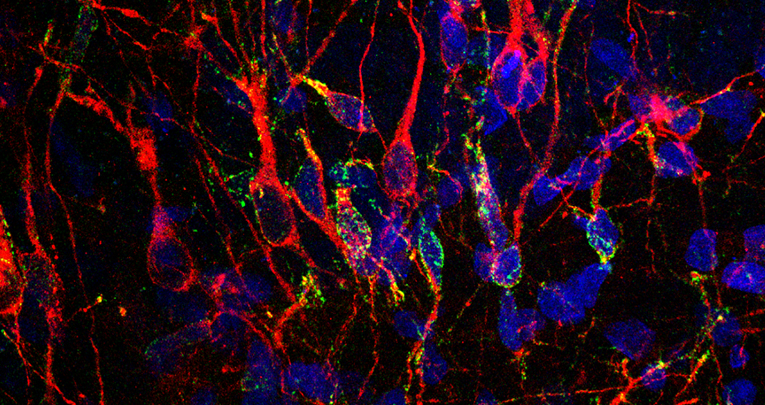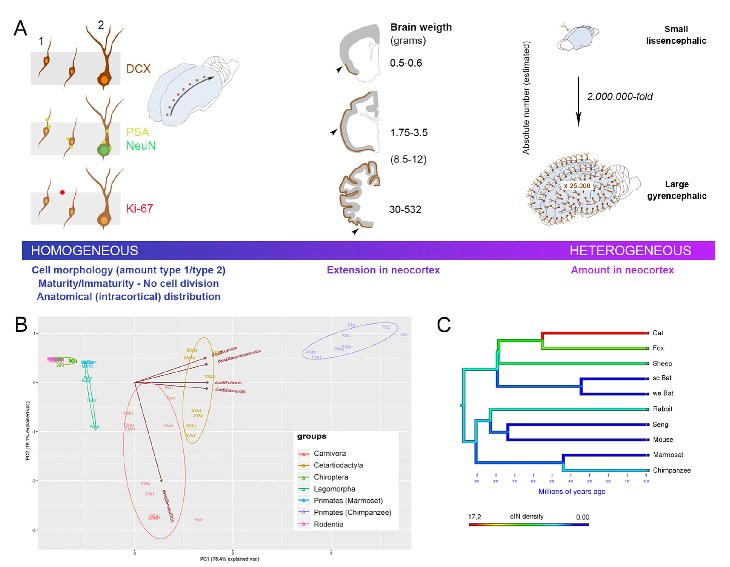
eLife, 21 July 2020
Phylogenetic variation in cortical layer II immature neuron reservoir of mammals
Chiara La Rosa 1,2 , Francesca Cavallo 1 , Alessandra Pecora 1 , Matteo Chincarini 3 , Ugo Ala 2 , Chris G. Faulkes 4 , Juan Nacher 5 , Bruno Cozzi 6 , Chet C. Sherwood 7 , Irmgard Amrein 8,9 , Luca Bonfanti 1,2*
eLife digest
Immature neurons prefer big brains
The cortex of larger-brained mammals contains pools of young, undifferentiated neurons that could enable brain plasticity.
To acquire new skills or recover after injuries, the mammalian brain relies on plasticity, the ability for the brain to change its architecture and its connections during the lifetime of an animal.
Creating new nerve cells is one way to achieve plasticity, but this process is rarer in humans than it is in mammals with smaller brains. In particular, it is absent in the human cortex: this region is enlarged in species with large brains, where it carries out complex tasks such as learning and memory. Producing new cells in the cortex would threaten the stability of the structures that retain long-term memories.
Another route to plasticity is to reshape the connections between existing, mature nerve cells. This process takes place in the human brain during childhood and adolescence, as some connections are strengthened and others pruned away.
An alternative mechanism relies on keeping some nerve cells in an immature, ‘adolescent’ state. When needed, these nerve cells emerge from their state of arrested development and ‘grow up’, connecting with the appropriate brain circuits. This mechanism does not involve producing new nerve cells, and so it would be suitable to maintain plasticity in the cortex. Consistent with this idea, in mice some dormant nerve cells are present in a small, primitive part of the cortex.
La Rosa et al. therefore wanted to determine if the location and number of immature cells in the cortex differed between mammals, and if so, whether these differences depended on brain size. The study spanned 12 mammal species, from small-brained species like mice to larger-brained animals including sheep and non-human primates.
Microscopy imaging was used to identify immature nerve cells in brain samples, which revealed that the cortex in larger-brained species contained more adolescent cells than its mouse counterpart. The difference was greatest in a region called the neocortex, which has evolved most recently. This area is most pronounced in primates – especially humans – where it carries out high-level cognitive tasks.
These results identify immature nerve cells as a potential mechanism for plasticity in the cortex. La Rosa et al. hope that the work will inspire searches for similar reservoirs of young cells in humans, which could perhaps lead to new treatments for brain disorders like dementia.
General features of cortical immature neurons are highly preserved in mammals whereas their amount is greater in large-brained species. (A)Some aspects, appear quite constant across the mammalian species(left), whereas their extension in the neocortex (middle) and their overall amount (right) vary remarkably, increasing from small, lissencephalic to large, gyrencephalic brains. (B) Principal Component Analysis (PCA; the different species are arranged according their orders). The animal species are identified by different colours. (C) Map of character evolution on the phylogenetic tree illustrating the independent emergence of neocortical DCX+ neuron densities in the mammalian species considered.
1
Neuroscience Institute Cavalieri Ottolenghi (NICO), Orbassano, Italy;
2
Department of Veterinary Sciences, University of Turin, Torino, Italy;
3
Università degli Studi di Teramo, Facoltà di Medicina Veterinaria, Teramo, Italy;
4
School of Biological and Chemical Sciences, Queen Mary University of London, London, United Kingdom;
5
Neurobiology Unit, BIOTECMED, Universitat de Valencia, and Spanish Network for Mental Health Research CIBERSAM, Valencia, Spain;
6
Department of Comparative Biomedicine and Food Science, University of Padova, Legnaro, Italy;
7
Department of Anthropology and Center for the Advanced Study of Human Paleobiology, The George Washington University, Washington DC, United States;
8
D-HEST, ETH, Zurich, Switzerland;
9
Institute of Anatomy, University of Zurich, Zurich, Switzerland








